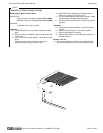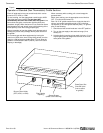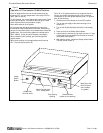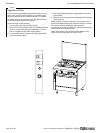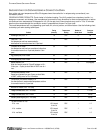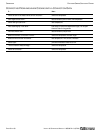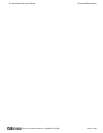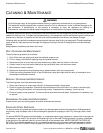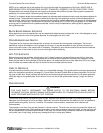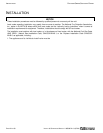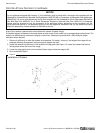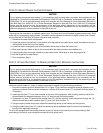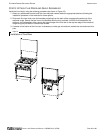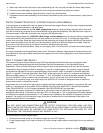
PLATINUM SERIES SECTIONAL RANGE CLEANING & MAINTENANCE
INSTALL AND OPERATIONS MANUAL 1185836 REV 3 (07/06) PAGE 23 OF 80
WOOL as any particles left on the surface will rust and further spoil the appearance of the finish. NEVER USE A
WIRE BRUSH, STEEL SCOURING PADS (EXCEPT STAINLESS), SCRAPER, FILE OR OTHER STEEL TOOLS.
Surfaces which are marred collect dirt more rapidly and become more difficult to clean. Marring also increases the
possibility of corrosive attack. Refinishing may then be required.
“Heat tint” is darkened areas that sometimes appear on stainless steel surfaces where the area has been subjected to
excessive heat. These darkened areas are caused by thickening of the protective surface of the stainless steel and
are not harmful. Heat tint can normally be removed by the foregoing, but tint which does not respond to this procedure
calls for a vigorous scouring in the direction of the polish lines using SCOTCH-BRITE scouring pads or a STAINLESS
scouring pad in combination with a powered cleanser. Heat tint may be lessened by reducing heat to equipment
during slack periods.
BLACK BAKED-ENAMEL SURFACES
Allow appliance to cool somewhat after use and wash black baked-enamel surfaces with a hot, mild detergent or soap
solution. In particular, clean off all grease deposits. Dry thoroughly with a dry cloth.
OPEN-BURNERS AND GRATES
The grates can be removed and cleaned with a solution of hot water and strong soap or detergent. The burners
themselves require little attention, but if spillage should occur, it may be necessary to clean around pilot areas, air
mixer and under burners. Use a wire brush if necessary. Periodically, open-burners should be removed and cleaned.
Allow the interior of the burner to drain, and dry thoroughly before replacing.
HOT-TOP SURFACES
Before cleaning hot-top surfaces, allow them to cool. If water is used on hot-tops while they are still hot, they may
crack, so avoid this practice. The hot-top plates can be removed and cleaned with hot water and detergent. A wire
brush may be used on the underside of the hot top plate. It is recommended not to clean tops while still on the range,
even if cooled, as excess water will drip into the burner box and deteriorate the metal.
CARE OF GRIDDLES
A griddle should be carefully cared for in order to avoid possible damage. (The griddle should have been tempered as
part of the installation procedure, see page 31). Use a Norton Alundum Griddle Brick to clean the griddle. Do not use
any type of steel wool. Small particles may be left on the surface and get into food products. Do not clean spatula by
hitting the edge on the griddle plate. Such action will only cut and pit the griddle plate, leaving it rough and hard to
clean.
OVEN INTERIOR
WARNING
FOR YOUR SAFETY, DISCONNECT THE POWER SUPPLY TO THE SECTIONAL RANGE BEFORE
CLEANING THE OVEN. WHEN CLEANING THE BLOWER WHEEL OF A CONVECTION OVEN, BE SURE TO
HAVE THE POWER SWITCH IN THE “OFF” POSITION.
To clean the oven interior, first allow the oven to cool. Remove oven bottom and clean it by rubbing with strong
detergent and a Brillo pad or similar scrubber. “Spillovers” should be cleaned from the bottom as soon as possible to
prevent carbonizing and a “burnt-on” condition. For stubborn accumulations, commercial oven cleaners are
recommended.
The porcelain oven door lining can be cleaned in a similar manner. The side, rear and top lining should be wiped only
with a cloth dampened with a mild detergent and water. Avoid using excessive amounts of water, as this may drip into
burner compartment and deteriorate the metal in that area. Do not use strong commercial cleaners or abrasive pads
on the side, rear or top linings, as they may damage the finish or leave gray residue.



